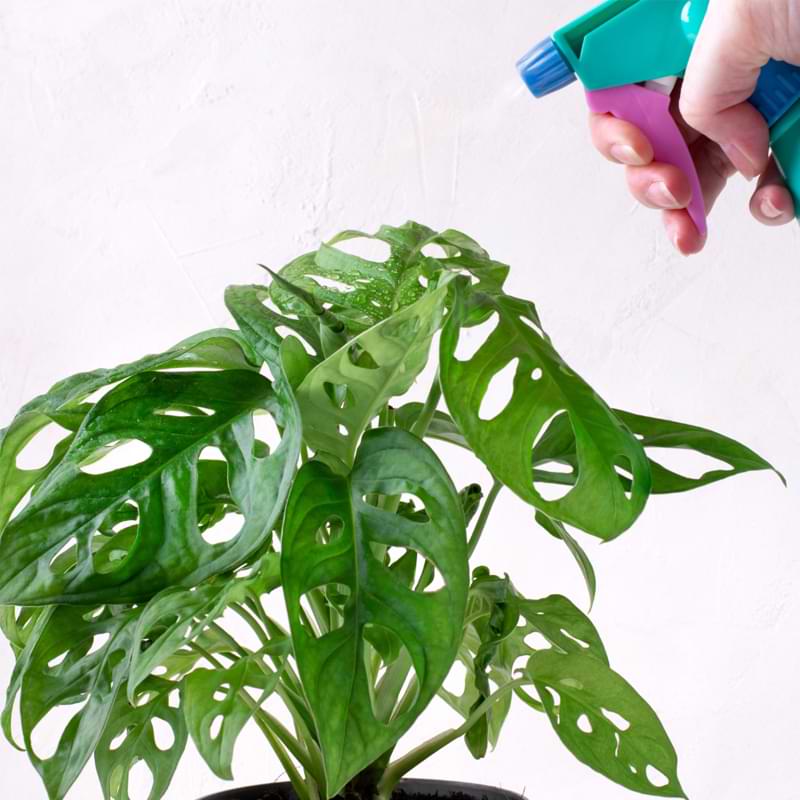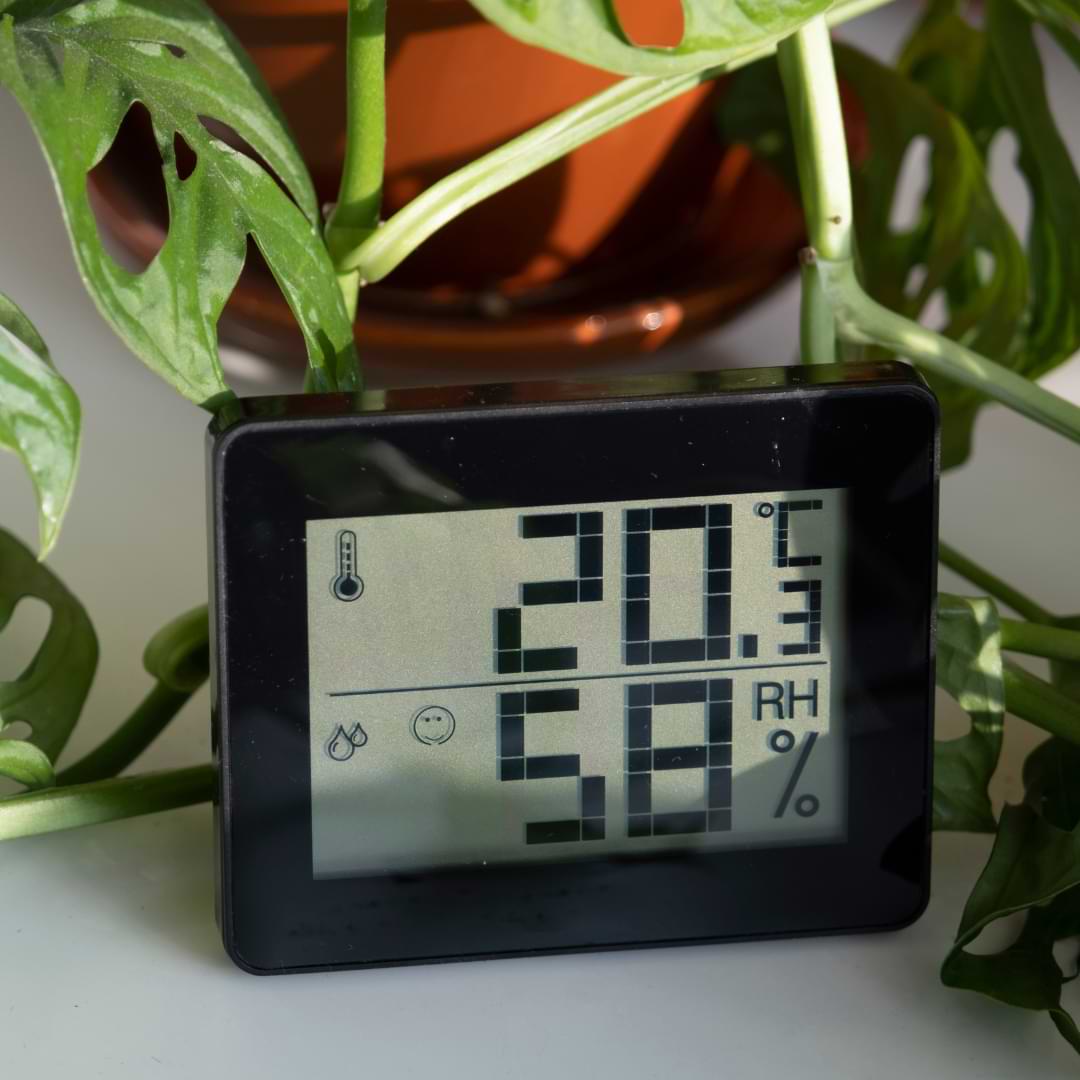Table of Contents
Do Monstera Like Humidity and Misting
You may have heard that the tropical Monstera loves humidity, but is there a certain amount they want, or is there such a thing as too much humidity? Luckily, we have some answers and general guidelines for monstera’s humidity levels and if you should be misting your gorgeous plant.
Monsteras In The Wild
Monstera plants are native to the tropical rainforests of Central and South America. In their natural habitat, they grow under the canopy of trees, where they receive dappled sunlight and a consistent level of humidity throughout the year.
These plants have adapted to survive in humid environments by developing large leaves with many perforations that allow them to absorb moisture from the air. They also have aerial roots that help them climb up tree trunks and absorb water from nearby sources.
In the wild, Monstera can grow up to 70 feet tall with leaves reaching up to three feet wide. These impressive sizes make them an important part of the ecosystem as they provide shelter for animals such as birds, insects, and monkeys.
While we may not be able to replicate these conditions in our homes, understanding how Monstera thrives in their natural environment can help us create similar conditions indoors. Now let’s explore what ideal indoor conditions are suitable for this beautiful plant.
Ideal Indoor Conditions For Monstera
Monstera plants are tropical by nature, which means they thrive in warm and humid conditions. When it comes to indoor growing, providing the right conditions is key to keeping them healthy and happy.
First, Monstera plants require bright but indirect light to grow. Direct sunlight can damage their leaves and cause them to burn or develop brown spots. However, placing your plant near a window that receives plenty of natural daylight is ideal.
Second, temperature plays an essential role in maintaining healthy growth for Monsteras. They prefer temperatures between 65-80°F during the day and slightly cooler at night.
Third and very important, humidity levels should be kept around 60%. Anything lower than this can lead to dryness in the air that may cause leaf browning or wilting.
Soil quality also affects Monstera’s health as they need well-draining soil with good aeration and water retention properties. Using organic matter like peat moss can improve your potting mix’s water-holding capacity while improving drainage.
Providing such ideal indoor conditions ensure you have a beautiful-looking monstera thriving indoors!
Finding The Humidity Levels In Your Home
Finding the right humidity levels in your home is crucial to maintaining a healthy environment for your Monstera plant. But how do you know what the humidity levels are? Here are some tips on finding out.
- Place a hygrometer near your Monstera and check it regularly to ensure that humidity levels remain consistent.
- Pay attention to any physical signs of low humidity such as dry skin or static electricity. If you experience these symptoms, chances are that the air is too dry for your Monstera plant.
- Research online about average indoor humidity levels in your area during different seasons. This will give you an idea of whether or not you need to adjust accordingly with methods like misting or using a humidifier.
By understanding and monitoring the humidity levels in your home, you can create an ideal environment for your beloved Monstera plant!

How To Increase Humidity For Monstera?
If the humidity levels in your home are low, there are several ways to increase moisture for your Monstera plant. There are several easy ways to increase the humidity around your Monstera to give your plant the right environment to thrive in.
1. Group Plants Together
Grouping plants together is an excellent way to increase the humidity levels in your home. As plants release moisture through transpiration, grouping them results in a more humid environment. You can either group several Monstera plants or mix them with other tropical plants that thrive well in high humidity.
When selecting which houseplants to group, it’s recommended to choose those that have similar care requirements and are compatible with each other. This will ensure they all thrive under the same conditions and don’t compete for resources.
It’s essential not to overcrowd your plant collection when grouping Monstera plants together. Overcrowding may lead to poor air circulation, which encourages pests and diseases. Ensure there is enough space between them so that air circulates freely.
Grouping also makes caring for your Monstera much easier as you can water multiple plants at once instead of watering each individually.
Grouping your Monstera with other house plants is an easy way of creating a more conducive environment for their growth by increasing humidity levels naturally without additional equipment like humidifiers.
2. Use A Tray With Pebbles
Another way to increase humidity for your Monstera plant is by using a tray with pebbles. This method involves filling a tray with pebbles and adding water until the water level reaches just below the top of the rocks.
Place your Monstera on top of the rocks, making sure that it’s not sitting in any standing water. As the water evaporates, it will create moisture around your plant, increasing the humidity levels.
Make sure to keep an eye on the water level in the tray and add more as needed. This method is easy and inexpensive compared to buying a humidifier or misting frequently. Plus, it’s aesthetically pleasing if you choose decorative stones or colors that match your home decor.
However, keep in mind that while this method does help increase humidity levels slightly, it may not be enough for plants that require very high humidity. This method would work great for Monstera plants, though.
3. Mist Your Plants With Water
Misting is a great way to increase humidity for your Monstera. It’s easy and can be done in just a few minutes each day. When you mist your plant, make sure the water droplets are small enough so that they don’t damage the leaves. A continuous spray water bottle gives the best results for this method, as the droplets are tiny and continuous. Just a light spray is needed to give your Monstera the humidity it needs.
The best time to mist is early in the morning when the air is cooler because this will allow more moisture to stay on the leaves. Avoid watering your Monstera at night as it can cause fungal growth on its leaves.
Mist your plant once or twice a day depending on how dry your home environment is. Misting too much may lead to overwatering, which can cause root rot and other issues.
If you’re using tap water, let it sit overnight before misting as this will help remove any chlorine or fluoride that may harm your plant. Alternatively, use distilled water instead of tap water for misting.
Misting helps mimic natural conditions for Monsteras by providing them with extra moisture in between watering sessions. Give it a try and see how much happier your Monstera becomes!
4. Use A Humidifier
Using a humidifier is one of the most effective ways to increase humidity for your Monstera plant. Humidifiers come in different sizes and shapes, making them easy to use in any room, and they work by emitting water vapor into the air, which increases the moisture content around your plant.
When using a humidifier, it’s important to keep an eye on the humidity levels in your home. You don’t want to create an environment that’s too damp or moist as this can lead to mold growth and other problems. Instead, aim for a comfortable range of about 40-60% humidity.
To get the most out of your humidifier, place it near your Monstera plant but not too close as you don’t want water droplets forming on its leaves all day long. Also make sure you clean and refill it regularly with distilled water.
Using a humidifier not only benefits your Monstera plant but also improves air quality and helps alleviate dry skin and respiratory issues for everyone in the house. It’s definitely worth considering if you live in areas where low humidity is common or during cold winter months when heating systems tend to dry up indoor air dramatically
5. Use The Most Humid Room in Your Home
One way to increase humidity for your Monstera plant is by locating it in the most humid room in your home. This could be the bathroom, kitchen or laundry area where moisture tends to accumulate.
However, before moving your Monstera into a new location, it’s essential to ensure that the light and temperature conditions are suitable for its growth. Check if there’s enough natural light and avoid placing it too close to cold windows or heat sources.
Once you’ve found the right spot for your Monstera, monitor its growth regularly. Observe if it’s thriving well in its new environment and adjust accordingly if needed. Remember that each indoor space can vary in humidity levels depending on factors like ventilation or air conditioning.
By utilizing this method, you’ll not only create an ideal environment for your Monstera but also benefit from having a more comfortable living space with improved air quality!

FAQ Monstera Humidity
Do Monsteras like steam?
Steam can be a great way to increase humidity levels for your Monstera plant. However, it’s important to note that Monsteras don’t necessarily “like” steam itself – they just benefit from the increased moisture in the air.
When you take a hot shower or run a humidifier, the resulting steam can help to create a more humid environment for your Monstera. This is because as the water evaporates from the steam, it adds moisture to the air around your plant.
It’s important not to overdo it with steam though – too much moisture in the air can lead to issues like mold growth or root rot. Be sure to monitor both humidity and temperature levels regularly if you’re using steam as a method of increasing humidity for your Monstera.
In addition, keep in mind that while some plants may enjoy being placed near a bathroom where there’s frequent use of hot water (and thus more steam), others may not appreciate being exposed to potential drafts or fluctuations in temperature. It’s always best to observe how your specific plant responds before making any major changes!
How often should I mist my Monstera plant?
Misting frequency really depends on the specific environment where your Monstera is living. If your home tends to be drier, then you may need to mist two to three times per day. If your home isn’t as dry, you may only need to mist once per day, or even every other day.





